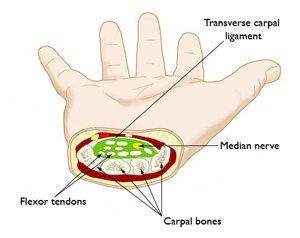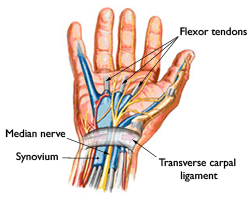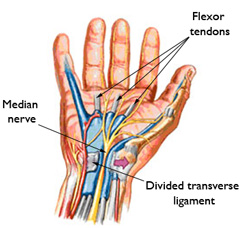
Carpal Tunnel Syndrome
This article is also available in Spanish: Síndrome del túnel carpiano.
Carpal tunnel syndrome is a common source of hand numbness and pain. It is more common in women than men.
AnatomyThe carpal tunnel is a narrow, tunnel-like structure in the wrist. The bottom and sides of this tunnel are formed by wrist (carpal) bones. The top of the tunnel is covered by a strong band of connective tissue called the transverse carpal ligament.
The median nerve travels from the forearm into the hand through this tunnel in the wrist. The median nerve controls feeling in the palm side of the thumb, index finger, and long fingers. The nerve also controls the muscles around the base of the thumb. The tendons that bend the fingers and thumb also travel through the carpal tunnel. These tendons are called flexor tendons.
 The carpal tunnel protects the median nerve and flexor tendons that bend the fingers and thumb.
Reproduced and adapted from Rodner C, Raissis A, Akelman E: Carpal Tunnel Syndrome. Orthopaedic Knowledge Online. Rosemont, IL, American Academy of Orthopaedic Surgeons, 2009.
Cause
The carpal tunnel protects the median nerve and flexor tendons that bend the fingers and thumb.
Reproduced and adapted from Rodner C, Raissis A, Akelman E: Carpal Tunnel Syndrome. Orthopaedic Knowledge Online. Rosemont, IL, American Academy of Orthopaedic Surgeons, 2009.
Cause
Carpal tunnel syndrome occurs when the tissues surrounding the flexor tendons in the wrist swell and put pressure on the median nerve. These tissues are called the synovium. The synovium lubricates the tendons and makes it easier to move the fingers.
This swelling of the synovium narrows the confined space of the carpal tunnel, and over time, crowds the nerve.
 Carpal tunnel syndrome is caused by pressure on the median nerve traveling through the carpal tunnel.
Carpal tunnel syndrome is caused by pressure on the median nerve traveling through the carpal tunnel.
Many things contribute to the development of carpal tunnel syndrome:
- Heredity is the most important factor - carpal tunnels are smaller in some people, and this trait can run in families.
- Hand use over time can play a role.
- Hormonal changes related to pregnancy can play a role.
- Age — the disease occurs more frequently in older people.
- Medical conditions, including diabetes, rheumatoid arthritis, and thyroid gland imbalance can play a role.
In most cases of carpal tunnel syndrome, there is no single cause.
Animation courtesy Visual Health Solutions, Inc.
SymptomsThe most common symptoms of carpal tunnel syndrome include:
- Numbness, tingling, and pain in the hand
- An electric shock-like feeling mostly in the thumb, index, and long fingers
- Strange sensations and pain traveling up the arm toward the shoulder
Symptoms usually begin gradually, without a specific injury. In most people, symptoms are more severe on the thumb side of the hand.
Symptoms may occur at any time. Because many people sleep with their wrists curled, symptoms at night are common and may awaken you from sleep. During the day, symptoms frequently occur when holding something, like a phone, or when reading or driving. Moving or shaking the hands often helps decrease symptoms.
Symptoms initially come and go, but over time they may become constant. A feeling of clumsiness or weakness can make delicate motions, like buttoning your shirt, difficult. These feelings may cause you to drop things. If the condition is very severe, muscles at the base of the thumb may become visibly wasted.
Doctor ExaminationTo determine whether you have carpal tunnel syndrome, your doctor will discuss your symptoms and medical history. He or she will also examine your hand and perform a number of physical tests, such as:
- Checking for weakness in the muscles around the base of your thumb
- Bending and holding your wrists in positions to test for numbness or tingling in your hands
- Pressing down on the median nerve in the wrist to see if it causes any numbness or tingling
- Tapping along the median nerve in the wrist to see whether tingling is produced in any of the fingers
- Testing the feeling in your fingers by lightly touching them when your eyes are closed
Electrophysiological tests. Electrical testing of median nerve function is often done to help confirm the diagnosis and clarify the best treatment option in your case.
X-rays. If you have limited wrist motion, your doctor may order x-rays of your wrist.
TreatmentFor most people, carpal tunnel syndrome will progressively worsen without some form of treatment. It may, however, be modified or stopped in the early stages. For example, if symptoms are clearly related to an activity or occupation, the condition may not progress if the occupation or activity is stopped or modified.
Nonsurgical Treatment
If diagnosed and treated early, carpal tunnel syndrome can be relieved without surgery. In cases where the diagnosis is uncertain or the condition is mild to moderate, your doctor will always try simple treatment measures first.
Bracing or splinting. A brace or splint worn at night keeps the wrist in a neutral position. This prevents the nightly irritation to the median nerve that occurs when wrists are curled during sleep. Splints can also be worn during activities that aggravate symptoms.
Medications. Simple medications can help relieve pain. These medications include anti-inflammatory drugs (NSAIDs), such as ibuprofen.
Activity changes. Changing patterns of hand use to avoid positions and activities that aggravate the symptoms may be helpful. If work requirements cause symptoms, changing or modifying jobs may slow or stop progression of the disease.
Steroid injections. A corticosteroid injection will often provide relief, but symptoms may come back.
Surgical Treatment
Surgery may be considered if you do not gain relief from nonsurgical treatments. The decision whether to have surgery is based mostly on the severity of your symptoms.
- In more severe cases, surgery is considered sooner because other nonsurgical treatment options are unlikely to help.
- In very severe, long-standing cases with constant numbness and wasting of your thumb muscles, surgery may be recommended to prevent irreversible damage.
 The ligament is cut during surgery. When it heals, there is more room for the nerve and tendons.
The ligament is cut during surgery. When it heals, there is more room for the nerve and tendons.
Surgical technique. In most cases, carpal tunnel surgery is done on an outpatient basis under local anesthesia.
During surgery, a cut is made in your palm. The roof (transverse carpal ligament) of the carpal tunnel is divided. This increases the size of the tunnel and decreases pressure on the nerve.
Once the skin is closed, the ligament begins to heal and grow across the division. The new growth heals the ligament, and allows more space for the nerve and flexor tendons.
Endoscopic method. Some surgeons make a smaller skin incision and use a small camera, called an endoscope, to cut the ligament from the inside of the carpal tunnel. This may speed up recovery.
The end results of traditional and endoscopic procedures are the same. Your doctor will discuss the surgical procedure that best meets your needs.
Recovery. Right after surgery, you will be instructed to frequently elevate your hand above your heart and move your fingers. This reduces swelling and prevents stiffness.
Some pain, swelling, and stiffness can be expected after surgery. You may be required to wear a wrist brace for up to 3 weeks. You may use your hand normally, taking care to avoid significant discomfort.
Minor soreness in the palm is common for several months after surgery. Weakness of pinch and grip may persist for up to 6 months.
Driving, self-care activities, and light lifting and gripping may be permitted soon after surgery. Your doctor will determine when you should return to work and whether there should be any restrictions on your work activities.
Complications. The most common risks from surgery for carpal tunnel syndrome include:
- Bleeding
- Infection
- Nerve injury
Long-term outcomes. Most patients' symptoms improve after surgery, but recovery may be gradual. On average, grip and pinch strength return by about 2 months after surgery.
Complete recovery may take up to a year. If significant pain and weakness continue for more than 2 months, your physician may instruct you to work with a hand therapist.
In long-standing carpal tunnel syndrome, with severe loss of feeling and/or muscle wasting around the base of your thumb, recovery is slower and might not be complete.
Carpal tunnel syndrome can occasionally recur and may require additional surgery.
Source: http://orthoinfo.aaos.org/topic.cfm?topic=A00005
